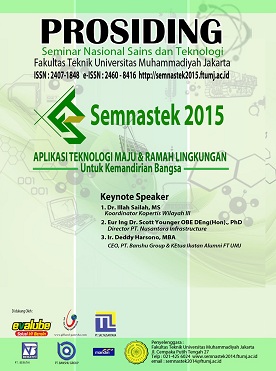PERMODELAN DAN SIMULASI PID KONTROL PADA ALAT PENUKAR PANAS
Abstract
Alat penukar panas secara luas digunakan untuk memindahkan panas dari fluida panas ke fluida dingin, sehingga pengendalian temperatur fluida aliran keluar dari alat penukar panas menjadi sangat penting. Pengendali PID secara konvensional dapat digunakan untuk mengoptimalkan suhu keluar dari alat penukar panas. Untuk pengendali PID alat penukar panas, nilai parameter tuning dihitung dengan metode tangent. Perancangan pengendali mengatur suhu fluida keluar pada pada set point yang diinginkan dalam waktu sesingkat mungkin tanpa memperhatikan massa aliran dan proses gangguan, ketidakstabilan peralatan dan tidak linier. Pengendali IMC Model memberikan hasil yang sangat baik pada overshoot dari kurva proses dibandingkan dengan pengendali klasik.References
Alfaro, V. M., Vilanova, R. & Arrieta, O. Two-Degree-Of-Freedom Pi/Pid Tuning Approach For Smooth Control On Cascade Control Systems. 47th Ieee Conference On Decision And Control, 2008 Cancun, Mexico. Ieee, 5680 - 5685.
Ang, K. H., Chong, G. & Li, Y. 2005. Pid Control System Analysis, Design, And Technology. Ieee Transactions On Control Systems Technology, 13, 559 - 576.
Åström, K. J. & Hägglund, T. 1995. Pid Controllers: Theory, Design, And Tuning, United State Of America, Isa.
Astrom K J And T Hagglund, “The Future Of Pid Control,” Control Engineering Practice, Vol. 9, 2001, Pp. 1163-1175
Fernando G. Martins, Manuel A.N Coelho, “Application Of Feed-Forward Artificial Neural Networks To Improve Process Control Of Pid Based Control Algorithms,” Computers And Chemical Engineering, Vol. 24, 2000, Pp. 853-858
Ho w k, t h lee, h p han and y hong, “self-tuning imc-pid control with interval gain and phase margins assignment,” ieee transactions on control systems technology, vol. 9, no. 3, may 2001, pp. 535-541
Ishak, a. A. & hussain, m. A. Reformulation of the tangent method for pid controller tuning. Tencon 2000, 2000 kuala lumpur. Ieee, 484 – 488
Kaddour najim, “process modeling and control in chemical engineering,” new york: marcel dekker, inc., 1989.
Kiam heong ang, gregory chong and yun li, “pid control system analysis, design and technology,” ieee transactions on control system technology, vol. 13, no. 4, july 2005, pp. 559-576
Liu g. P and s. Daley, “optimal-tuning pid control for industrial systems,” control engineering practice, 9, 2001, pp. 1185-1194
Malleswararao y.s.n and m chidambaram, “non-linear controllers for a heat exchanger,” journal of process control, vol. 2, no. 1, 1992, pp. 17-21
Mansour, t. 2011. Pid control: implementation and tuning, united state of america, intech.
Marlin, t. E. 2000. Process control designing processes and control systems for dynamic performance, united state of america, mcgraw-hill science
Rajiv mukherjee, “effectively design shell-and-tube heat exchangers,” chemical engineering progress, feb 1998, pp. 1-17
Riggs, j. B. 2001. Chemical process control, united state of america, ferret publishing.
Ramesh k. Shah and dusan p. Sekulic, “fundamentals of heat exchanger design,” usa: john willey and sons, 2003
Sharma, c., gupta, s. & kumar, v. Modeling and simulation of heat exchanger used in soda recovery. World congress on engineering, 6 - 8 july 2011 2011 londok. Newswood limited, 1406 - 1409.
Trikha, m., sharma, n., singhal, m. & pandey, a. 2012. Heat exchanger system controlled by fuzzy self-adapting pid controller. Mit international journal of electrical and instrumentation engineering, 2, 31 – 36

